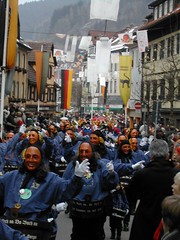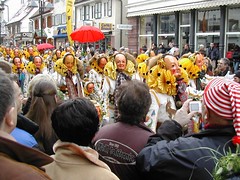Narri? Narro!
I spent Sunday in the Black Forest with Slim and Larry and her friends and family, at the Hanselsprung in Schramberg, and very nice it was too. I haven't had that much fun in ages. (There are some more photos on Flickr, but not many since I had my hands full with Larry and/or his pushchair much of the time. Slim also had a camera, I'll ask whether she will let me post some of hers.)

The Hanselsprung is the first day of Fasnet, the (catholic southern) German Carnival, and the procession in Schramberg is the finest in the land. The day begins with the mayor handing the keys to the Rathaus to the chief of the Narren, who then march through the streets in procession with bells and whistles and brass bands.

Their route leads them back to the Rathaus, from whence they fan out distributing Bretzeln, Gutsle and Würstle to the eager public - at least, to those who sing the song of the day while hopping on the spot:
Hoorig, hoorig, hoorig isch die Katz,
Und wenn die Katz net hoorig isch,
No g'fällt se dena Meidle nit,
Hoorig, hoorig, hoorig isch die Katz!
Slim grew up in Schramberg, a small town in a big forest, and is still known there although she has lived away for twenty years. We were continually meeting people who knew her, including a few Narren. At one point, she went up to an elderly woman and asked "Are you Frau X?" The woman replied, "No, but I know her - and you! You're E's daughter Slim, aren't you?" Truly a small town.
But the neatest event of the day was discovered in retrospect. I work with G and W, who grew up in Aichhalden, just over the hill from Schramberg, and have been to their parents' houses often. G's parents were at the Hanselsprung, and his father recognised me in the crowd, but couldn't get close enough to say hello. Truly a small world.
[Update: Read the comments for a lengthy description of the figures and events of Fasnet. I also corrected the Hoorig Katz song, having previously quoted a different version to that which is sung in Schramberg.]




6 Comments:
I love festivities! How fun :) Are those sunflower costumes or what? I couldn't quite make them out.
What is Da-Bach-Na-Fahrt?
More on this in English, if you don't mind, for those of us whose German extends to:
Ich bin Auslander und spreche nicht gut Deutsch. Ich esse kein Fleisch.
Your photos are beautiful. I love the colors of this holiday. Is this about Spring?
Fasnet is the German Carnival, the feast before Lent starts on Ash Wednesday. The nature and timing of the celebrations differ quite strongly between towns, and also between the largely Protestant north and the largely Catholic south. In Schramberg, all business stops for four days; in Stuttgart, business closes for a single half-day, for the parade on Veilchendienstag (everything but the train station is closed on Sundays anyway).
At some time in the past, the religious Fasnet became combined with a cheerfully pagan end-of-winter celebration: the first figure in the Hanselsprung is called Kehraus, he sweeps away the remains of winter before the parade.
The principal figure of the Hanselsprung is present only in spirit: the Hoorig Katz, the hairy cat. She ("cat" is feminine in German) appears on banners and costumes, and in the song you must sing to get a Bretzel or a candy from a Narre.
The costumes and masks are traditional patterns, scrupulously maintained without change over generations. The Narren (fools) are organised in clubs, which march together with their own bands.
There are three types of Narren. The vast majority are of the type called Hansel (as in the Brothers Grimm fairytale, but a fairly common given name). The mask is ringed with horsehair and has a fox's tail fixed to the top, as a symbol of the Fool's cleverness. (No, I don't know whether all the hundreds of foxtails we saw actually belonged to real foxes. The sheer numbers incline me to believe that at least some must be "fun fur".) The white linen costume is decorated with a fox and a bear on the breast; on the back is an eagle with a sword; on the seat of the pants a sundial (representing the once-mighty Junghans clock and watch factory which dominated the town, long gone); the ruffled yellow collar is just for fun. They wear a harness of bells around the waist and down each leg, and carry a wooden staff from which Bretzeln are later stacked and distributed.
The second type is the Narro, a super-Fool. His costume is a mass of visual allusions to the local dialect: The horns on the mask show that he may mock anyone (jeder auf den Hörner nehmen); two foxtails show that the Narro is twice as smart as a Hansel. The white linen costume is decorated with the town arms on the front, surrounded by interwoven plants, insects, flowers and pinecones typical of the region; finches and butterflies on the sleeves show that Spring will come soon; the back shows the Hoorig Katz on a rooftop; all woven over with spiderwebs (the word "to spin" can also be used to mean "you must be mad"). Their trousers are decorated with a man on one leg and a woman on the other, because men and women always have been and always will be foolish. The Narro carries a woven basket, and distributes candies and chocolates. They too wear a harness of bells and a purely decorative ruffled collar.
The third type, the Bruele, is a modern figure expressive of the poverty and hunger of the winters after the second world war. Their white linen costume is decorated only on the back, with the cat-on-the-rooftop motif. The mask is marked by deep worry lines, a pessimistic frown and cartoon tears. The straw hat represents another once-mighty local industry, also long gone. The Bruele ("crier") carries an open umbrella, no matter how fine the weather. They distribute candies and chocolates from a wicker basket. They have no bells on their costume.
Not only Narren take part in the parade. A new figure was canonised in 1955, the Bach-na-Fahrer. The Bach-na-Fahrer wear blue shirts and a wooden wine barrel, from which they distribute sausages. The figure celebrates the traditional river-rafting competition Da Bach na Fahrt on Rosenmontag (the Monday before Ash Wednesday), in which local fools (as opposed to Fools) attempt to sail the length of the Schiltach in exuberantly decorated homemade rafts. Points are awarded not for completing the course, because in 68 years nobody has ever done so, but for grace and decorum while falling in.
(My free translation of the official town website (link on the main page, follow the links for some detail photos of the individual characters), combined with personal observations.)
I just read your comment in Little Light's blog about the fig tree that Jesus cursed and wanted to say THANK YOU for that amazing perspective.
I never though about it that way... and of course it had never been presented that way in any of my Sunday school classes (what a shock).
anyway, just wanted to say thanks!
In case anyone is interested: here is the Little Light post that Brian was responding to.
http://alesally.blog.excite.it/permalink/508803
Post a Comment
<< Home